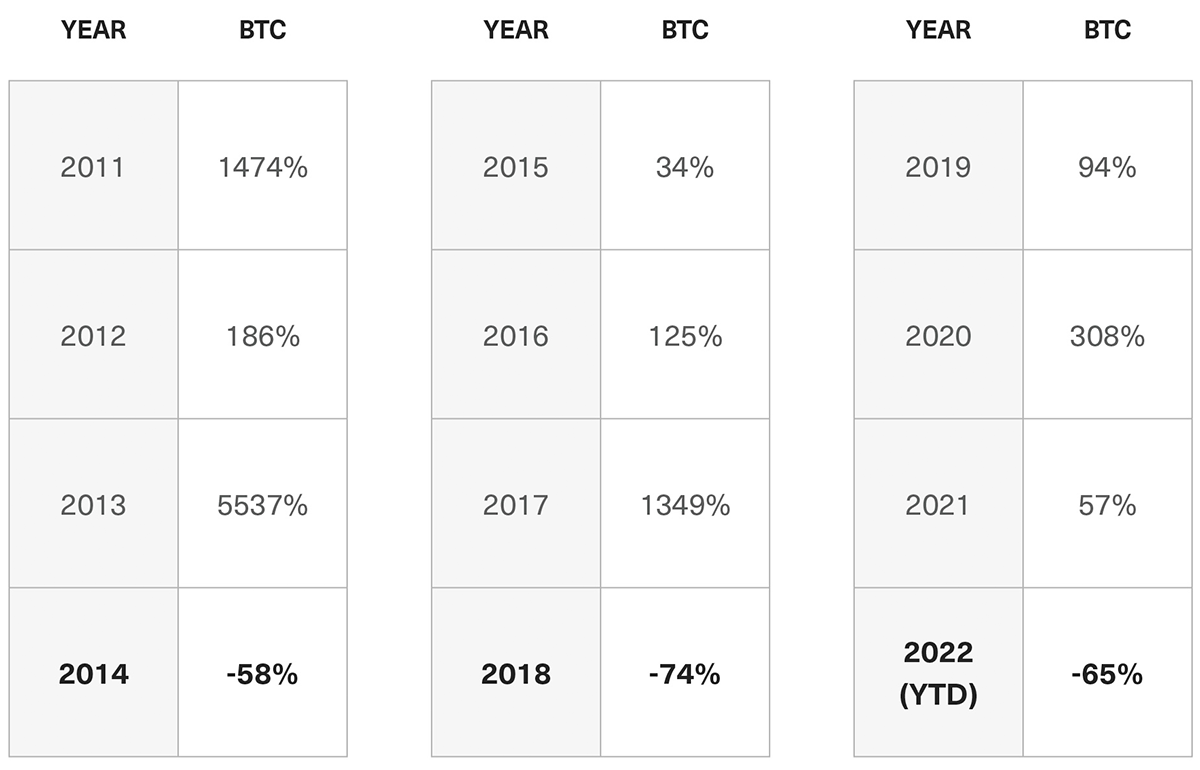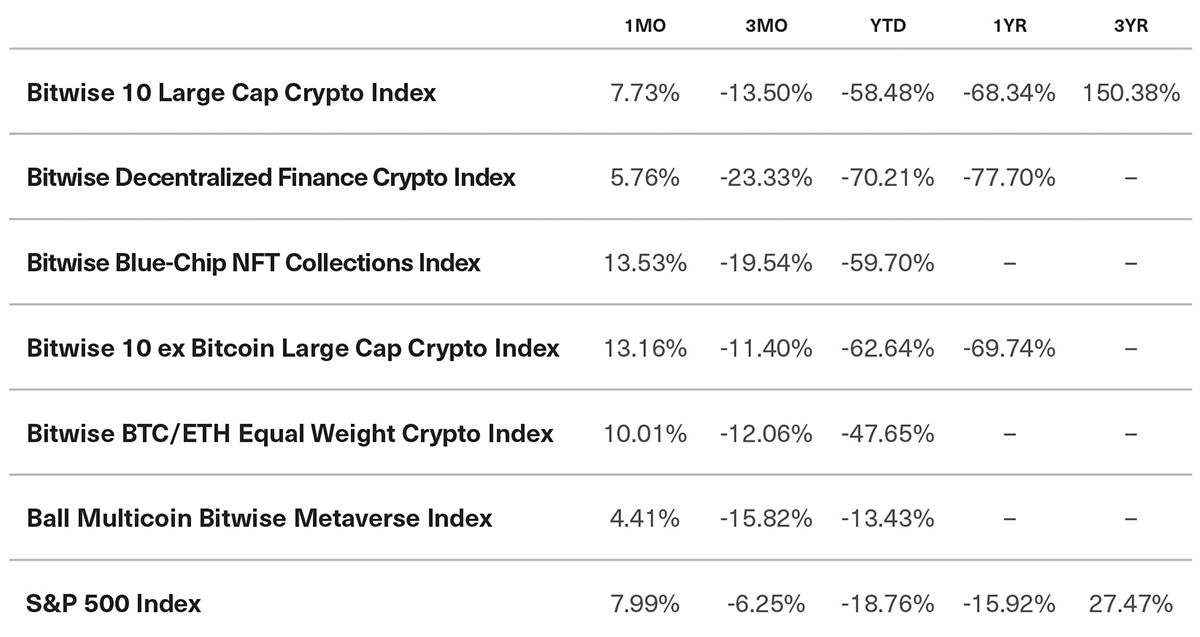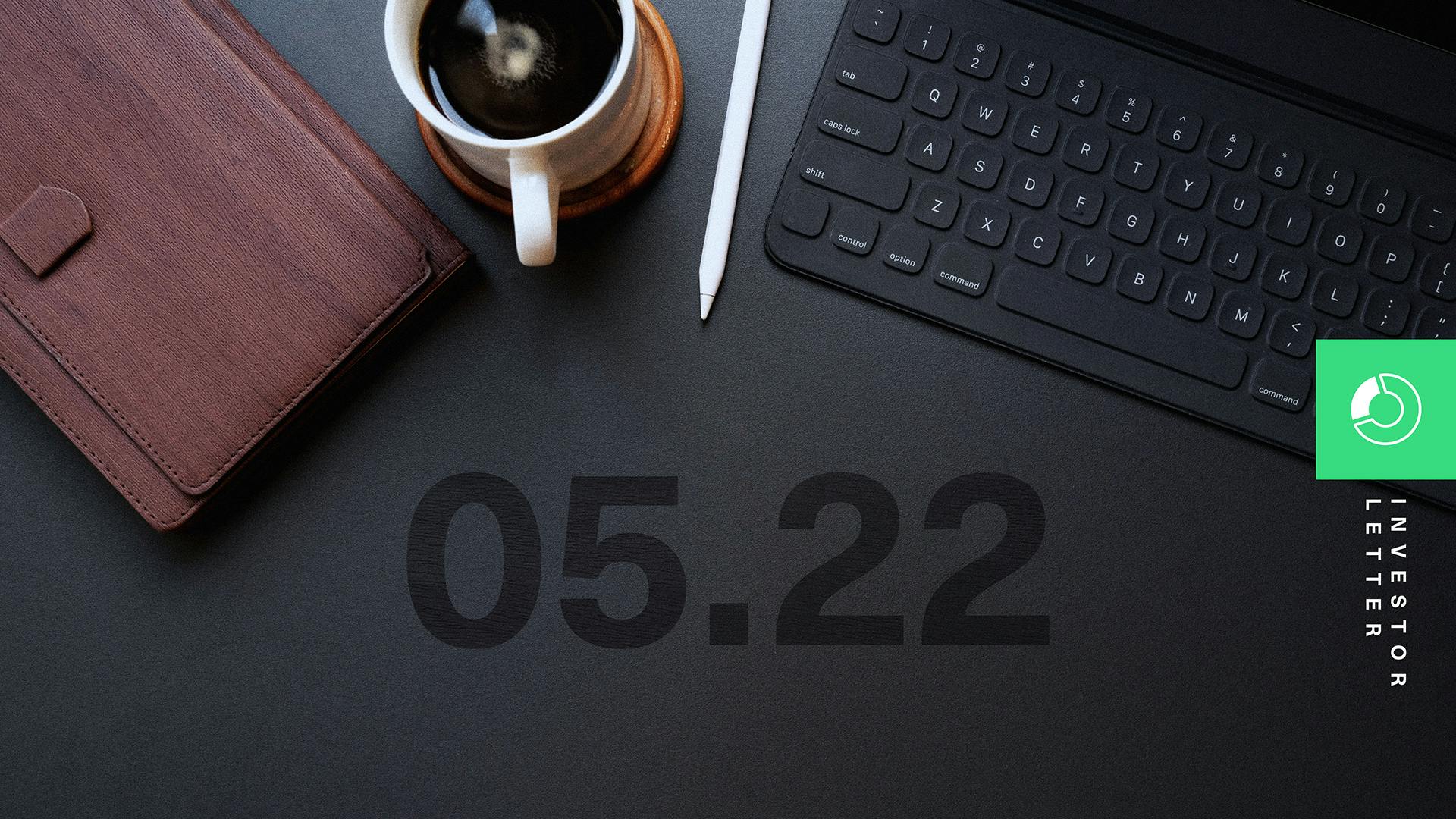November 2022 Bitwise Investor Letter
San Francisco • Nov 15, 2022
In This Issue: What FTX’s Collapse Means for Crypto
Market Overview
Dear Investors,
Earlier this month, FTX—the third-largest crypto exchange in the world—collapsed.
The firm’s CEO, a media darling whom Fortune magazine dubbed the “The Next Warren Buffett,” appears to have engaged in a massive and perhaps criminal fraud, appropriating customer assets and funneling them to an affiliated hedge fund. The firm filed for Chapter 11 bankruptcy protection on November 10 and reportedly has more than one million creditors.
The news has shaken the crypto industry and sent crypto prices down. Bitcoin, which had been trading around $20,000 before FTX’s meltdown, is now trading around $16,000. Ethereum, which was trading near $1,600, is now below $1,300.
Critics have characterized FTX’s downfall as proof that crypto itself is flawed, a failed idea built on sand. But that argument doesn’t stand up to scrutiny. Fraud, unfortunately, has cast a long shadow throughout the history of finance. The potential existence of fraud at FTX does not invalidate crypto and blockchain any more than the existence of Bernie Madoff invalidated stocks and options.
But arguments that FTX “doesn’t matter” are equally hollow. FTX was a high-profile firm. Its name was stamped on the uniforms of MLB umpires and on the stadium of the NBA’s Miami Heat. Its CEO, Sam Bankman-Fried (SBF), was well known in Washington, both for his crypto lobbying efforts and for his status as one of the largest political donors in America.
As such, FTX’s collapse will shape crypto for months and years to come, in ways both good and bad.
So in this month’s Investor Letter, let’s face up to FTX: what it means, what it doesn’t mean, and how it will shape crypto in the years to come.
Note: Bitwise has no affiliation with FTX. We did not trade or custody assets on FTX.
What FTX Doesn’t Change About Crypto
The place to start is what FTX does not change about crypto. It’s a long list.
The collapse of FTX does not change anything about blockchain technology. It does not change crypto’s ability to move money at the speed of the internet, program money like software, or create digital property rights. It does not change the advances of decentralized finance (DeFi), and it neither makes stablecoins less interesting nor truncates the long-term possibilities created by non-fungible tokens (NFTs). It does not reverse the incredible progress we have made in recent years on crypto infrastructure, from the rise of regulated custodians to the development of the regulated CME bitcoin futures market.
Similarly, it does not change the fact that there is a record number of developers working in crypto, or that Ethereum SDK installations—an indicator of how many applications are being built on Ethereum—have tripled in the past year alone. FTX’s alleged fraud does not change that Ethereum’s monthly revenue is up 32x over the past four years.
FTX does not alter the fact that crypto has received more venture capital in the past two years than it did in the preceding 10, nor does it detract from the incredible progress we’ve made recently in blockchain technology itself: 2022 has seen the successful execution of Ethereum’s Merge (which, among other impacts, cut that blockchain’s carbon consumption by 99%) along with the rise of Layer 2 solutions that (in combination with other technological upgrades) are expected to increase blockchain bandwidth more than 10,000-fold in the coming years.
In other words, FTX doesn’t change the fundamentals of crypto in any meaningful way. It does, however, alter the conditions we operate in.
What FTX Does Change About Crypto
In the short term, FTX’s collapse has destroyed trust and introduced uncertainty into the market. The marginal crypto investor will now think twice before signing up for an account, and many institutional investors will sit on the sidelines waiting to see what other shoes will drop. It’s a reasonable stance: We will likely see other firms pulled away by FTX’s undertow, and we don’t yet know the full extent of any contagion.
In the intermediate-to-long term, FTX’s collapse will accelerate and intensify regulatory scrutiny in the space. While regulators bear some of the blame for FTX’s unchecked rise—the lack of regulatory clarity in the U.S. pushed trading venues offshore—politicians and regulators alike will seize on the high-profile collapse to claim that we must tame the Wild West of crypto immediately. We are already seeing this in Congress, which is likely to hold hearings on the FTX debacle, and from SEC Chairman Gary Gensler, who lays the blame for FTX’s collapse on the lack of regulatory enforcement.
Long-term, increased regulatory clarity will be good for crypto. A murky regulatory environment keeps investors on the sidelines and stifles the creativity of crypto entrepreneurs. Ironically, the collapse of FTX may end up being a catalyst for the next bull market in crypto, which needs clear regulation to go mainstream.
But regulation made in haste brings risk, and FTX’s collapse increases the likelihood we see rules adopted in a manner that doesn’t give the industry time to adapt. (For a good review of what’s at stake from a regulatory perspective, read this insightful take from Chainalysis.)
Beyond that, FTX’s collapse will also likely pause and/or diminish the flow of venture capital funding into crypto. A huge number of VC firms had exposure to FTX’s equity, and they will have to write that down to zero. Some, like Sequoia, heavily promoted their investment in FTX and now have egg on their faces. They will be unlikely to return to crypto quickly. Even funds that didn’t have exposure will find it harder to raise new assets, as their institutional clientele will want to know how they are protected from the “next FTX.” The venture capital spigot will likely slow to a trickle for a year or more as firms adapt.
VC Money Invested in Crypto/Blockchain by Stage

Source: Galaxy Digital Research, "2021: Crypto VC's Biggest Year Ever," January 6, 2022, with data from Pitchbook.
Note: New data on venture capital activity covering 2022 will not be made available on a standardized and comprehensive basis from Galaxy Research or other providers until early 2023. Other researchers have noted that venture capital activity has declined somewhat in 2022 vs. 2021. For instance, KPMG reported its "Pulse of Fintech" report that H1 2022 venture capital activity in crypto totaled $14.2 billion, the equivalent to $28.4 billion on an annualized basis (compared to their estimate of $32.1 billion in crypto venture activity in 2021).
So, What Does This All Mean for the Next Crypto Cycle?
In the past half year at Bitwise, we have been talking about the “next bull cycle in crypto.”
As we’ve discussed, crypto has historically moved in four-year waves, with three big up years followed by a year of pullback. The table below shows the annual returns of bitcoin as a proxy for crypto as a whole, and is updated with data through November 13, meaning it incorporates the FTX-induced pullback.
Crypto Has Historically Moved in a Four-Year Cycle

Source: Bitwise Asset Management. Data from January 1, 2011, through November 13, 2022. Performance information is provided for informational purposes only. Returns reflect the return of bitcoin itself, and not of any fund or account, and do not include any fees. Backward-looking performance cannot predict how any investment strategy will perform in the future. Future crypto cycles may not be four years long; the four-year increment is based on historical data for illustrative purposes and is not a prediction of future results. This material represents an assessment of the market environment at a specific time and is not intended to be a forecast of future events, or a guarantee of future results.
The pattern is striking, but it's not a coincidence. These waves are driven by major technological upgrades and represent the market’s response to those upgrades.
The first wave—from 2011 to 2014—was driven by Bitcoin itself. 2011 was the first year investors could buy bitcoin, with the launch of Coinbase, Mt. Gox, and other crypto on-ramps. These tools brought new investors into the space, pushed prices up, and inspired a wave of crypto engineers to think about what else blockchain technology could do.
The market pulled back when Mt. Gox collapsed; the exchange, built on rickety infrastructure and with no regulatory framework, couldn’t hold up under the surge of demand.
The second wave—from 2015 to 2018—was driven by entrepreneurs who were pulled into crypto by the first wave. These entrepreneurs created Ethereum in 2015 as the first general-purpose blockchain, among other achievements. This technological breakthrough sparked massive new opportunities for investors and kicked off the initial coin offering (ICO) boom, sending prices higher.
The market reset in 2018 as regulators clamped down on the excesses of ICOs; once again, crypto got ahead of itself. But the excitement around the 2015-2018 boom laid the groundwork for the next wave of crypto, bringing significant venture capital activity into the space. And from 2019 to 2021, VC- and angel-backed entrepreneurs created multiple new blockchain-based breakthroughs—DeFi! Stablecoins! NFTs!—which together catalyzed the most recent bull market.
That wave has, of course, crested and withdrawn, pulled back by a tough macro environment and once again by crypto expanding too fast and taking on too much risk, as evidenced by the crypto credit crisis that took down Celsius and BlockFi, and now the FTX fraud. But just as 2015-2018 laid the groundwork for 2019-2022, so too has this last boom sown the seeds of what’s to come.
From 2019 to H1 2022, investors have poured $57 billion of venture capital into crypto, according to KPMG—many times the amount that entered the market from 2015-2018. This money is funding a record number of engineers and entrepreneurs building in the space. And with the rapid improvements in blockchain technology, I feel confident we’ll see enormous new applications emerge in the coming years.
From my seat, the biggest impact FTX will have is that these entrepreneurs are likely to be building in a more carefully regulated, more sound, and more mainstream market. As one example, centralized exchanges are already adopting cryptographically native approaches to building investor trust through initiatives like “Proof of Reserves,” in which exchanges use the transparency of blockchains to prove that customer assets are held securely in stand-alone wallets.
Ingenuity often springs from adversity. As JPMorgan put it in a recent research note on FTX’s collapse:
[W]e see the news surrounding FTX as one step back, but one that could prove to be the catalyst to move the crypto economy two steps forward (further unlocking the utility value of blockchain). In fact, we see the establishment of a regulatory framework as the needed catalyst to massively ramp the institutional adoption of crypto.
Indeed.
Developments like FTX hurt. They are disappointing, frustrating, and they set the industry back. But ultimately, they don’t alter crypto’s destination. They just make the journey a bit longer … and a lot bumpier.

Matt Hougan
Chief Investment Officer
Events
Going to any of these upcoming events? So is Bitwise. We’d love to connect in person. Email investors@bitwiseinvestments.com if you’d like to set up a one-on-one meeting.
Conferences
Bitwise Financial Forum | November 17 | New York, NY
TechCrunch Sessions: Crypto 2022 | November 17 | Miami, FL
Financial Planning Association – Chapter Leaders Conference | November 18-20 | Westminster, CO
IWI Forum | November 29-December 1 | New York, NY
Barron’s Advisor Women Summit | November 30-December 2 | Palm Beach, FL
Bitwise Financial Forum | December 8 | San Francisco, CA
Notes From the Research Desk
Polygon: Where Crypto Is Taking Shape for Large Companies
What do Meta, Starbucks, Reddit, and Robinhood all have in common? They all chose Polygon, a top Ethereum scaling solution, as their gateway into Web3. Take Reddit: Since it launched its Polygon-hosted NFT marketplace in July, three million Reddit users have created a crypto wallet to purchase an NFT, generating over $10 million in cumulative sales. Then there’s Robinhood: In September, the company announced Polygon as the blockchain of choice for the release of its Web3 wallet. While the beta version is available to only 10,000 users, imagine the increase in Polygon’s network activity once Robinhood makes the crypto wallet available to all of its 22+ million users.
The announcements are bullish for Polygon and, in turn, for the Ethereum ecosystem. In October, Polygon and Ethereum rallied 16% and 18%, respectively. Numbers aside, it’s all the more impressive when you consider the timing. Big-name companies are entering Web3 amid a bear market, and that could serve as a catalyst for the next bull run.
Another Miner Bites the Dust? Core Scientific on the Brink of Bankruptcy
The world’s largest bitcoin mining company, Core Scientific (CORZ), is at risk of filing for Chapter 11 protection. The company cited higher electricity costs, lower bitcoin prices, and ongoing litigation with troubled crypto lender Celsius as the main causes. Core Scientific retained legal and financial counsel to seek strategic alternatives to improve its liquidity position. It’s estimated that current cash resources could be depleted by the end of the year.
The news doesn’t come entirely as a surprise. Core Scientific was by far the most leveraged bitcoin miner with a leverage ratio over 2x its equity, totalling over a billion dollars in debt. Our view remains unchanged during these tough times for the bitcoin mining industry: Companies with healthy, deep balance sheets and lower production costs should emerge in an improved position and gain market share from weaker competitors.

Alyssa Choo
Crypto Research Analyst
DeFi Protocols Accelerate Integration With Real-World Assets
MakerDAO, one of the most prominent DeFi projects and the issuer of the leading crypto-backed stablecoin DAI, is spearheading the integration of real-world assets and crypto. The protocol entered into a partnership with Coinbase in which the exchange will custody up to $1.6 billion in USDC owned by MakerDAO, allowing the protocol to earn 1.5% interest (or about $24 million in annual interest revenue).
The news comes on the heels of MakerDAO's decision to begin investing $500 million of its reserves in a combination of U.S. Treasuries and corporate bond ETFs, generating an additional annual revenue opportunity of ~$17 million.
This is exciting news for two reasons: First, it highlights the opportunity for DeFi protocols to generate massive revenue streams with their idle resources. Second, it marks another milestone in integrating traditional finance and DeFi, one of the defining trends that we believe will fuel the next cycle in DeFi.

Ryan Rasmussen
Head of Research
Benchmark Performance
As of October 31, 2022

Source: Bitwise Asset Management with data from Bloomberg.
Notes: It is not possible to invest directly in an index. Past performance is no guarantee of future results. The Bitwise 10 Large Cap Crypto Index captures the 10 largest eligible crypto assets by free-float-adjusted market capitalization. The Bitwise Decentralized Finance Crypto Index is designed to provide investors with a clear, rules-based, and transparent way to track the value of the rapidly emerging Decentralized Finance space. The Bitwise Blue-Chip NFT Collections Index is designed to broadly capture the investable market opportunity for the most valuable arts and collectibles NFT collections. The Bitwise 10 ex Bitcoin Large Cap Crypto Index captures the assets in the Bitwise 10 Large Cap Crypto Index, excluding bitcoin. The Bitwise BTC/ETH Equal Weight Crypto Index captures the value of an equal-weighted index consisting of bitcoin and ethereum. The Ball Multicoin Bitwise Metaverse Index is designed to capture the investable market opportunity for crypto assets exposed to the emerging Metaverse. The S&P 500 Index, or Standard & Poor's 500 Index, is a market-capitalization-weighted index of 500 leading publicly traded companies in the U.S.
What’s New at Bitwise
Market Update: FTX Collapse Rattles Crypto Markets—Where Do We Go From Here?
The crypto markets have seen significant volatility in the aftermath of FTX’s collapse, but will the event alter crypto’s long-term trajectory? Bitwise CIO Matt Hougan explains the sudden fall of the once-leading crypto exchange—and what it means for crypto.
Crypto Market Quarterly Review: Q3 2022
After a difficult first half of the year, Q3 was, very quietly, a decent quarter for crypto. In this data-driven report, our research team outlines the key themes shaping crypto markets across Bitcoin, Ethereum & emerging L1s, DeFi, NFTs, and crypto equities.
We Expanded to Active Strategies
Bitwise recently expanded its capabilities with a world-class active investing strategy to meet the fast-growing institutional demand for liquid crypto strategies. The active team is led by a newly assembled group of experts, headed by Jeffrey Park, CFA. Park, formerly at Corbin Capital, brings nearly a decade of experience as a crypto investor.
The Top 3 Questions From Advisors in October (Video)
Last month, Bitwise CIO Matt Hougan and Bitwise General Counsel and CCO Katherine Dowling answered advisors' most pressing questions about crypto: how to know when it’s a good time to invest, how to approach tax-loss harvesting, and what crypto legislation to look out for.
Select Media Appearances
CNBC: Learnings from FTX’s liquidity crunch (Hunter Horsley)
CheddarTV: Cryptocurrency exchange FTX teeters near bankruptcy (Matt Hougan)
Blockworks: DeFi is more robust than CeFi (Ryan Rasmussen)
Cointelegraph: Bitwise launches Web3 ETF for institutional and retail investors (Hunter Horsley)
Blockworks: Bitwise forms an active strategies team (Jeff Park)
Bitwise Asset Management is a global crypto asset manager with more than $15 billion in client assets and a suite of over 30 investment products spanning ETFs, separately managed accounts, private funds, hedge fund strategies, and staking. The firm has an eight-year track record and today serves more than 4,000 private wealth teams, RIAs, family offices and institutional investors as well as 15 banks and broker-dealers. The Bitwise team of over 125 technology and investment professionals is backed by leading institutional investors and has offices in San Francisco, New York, and London.


